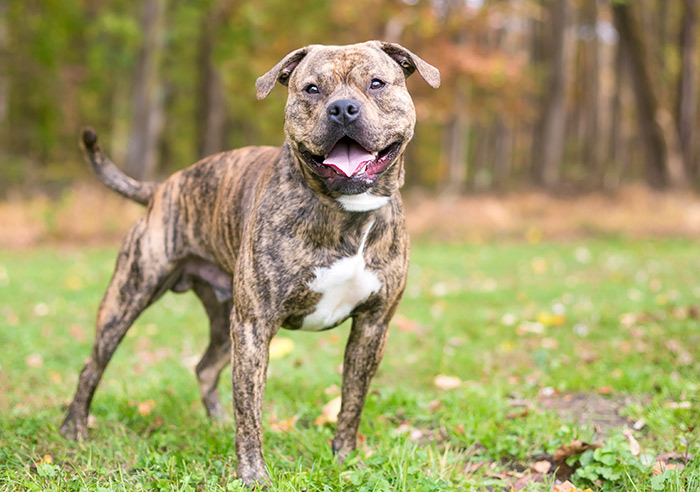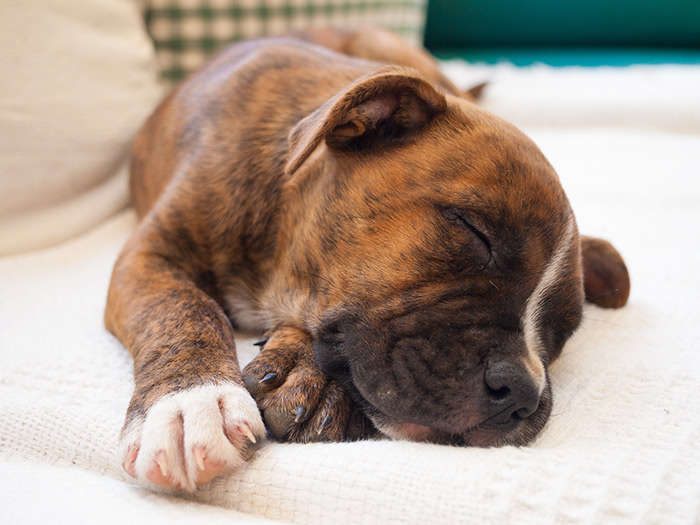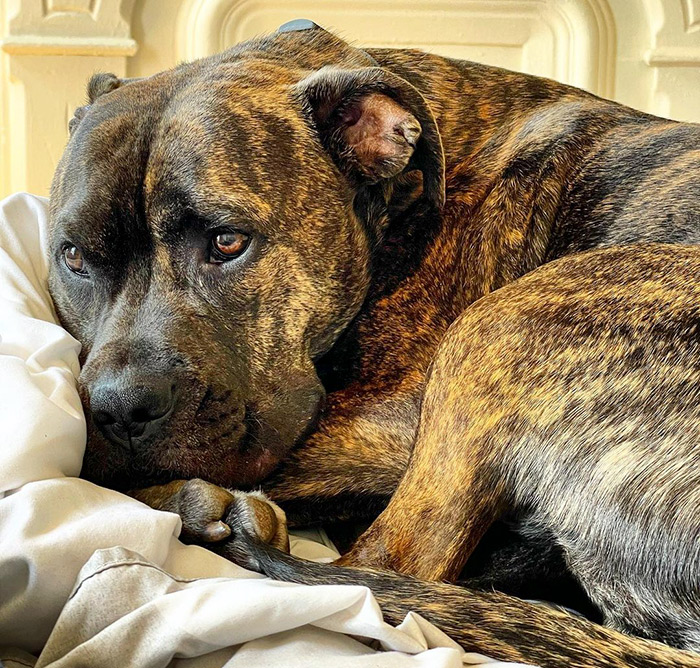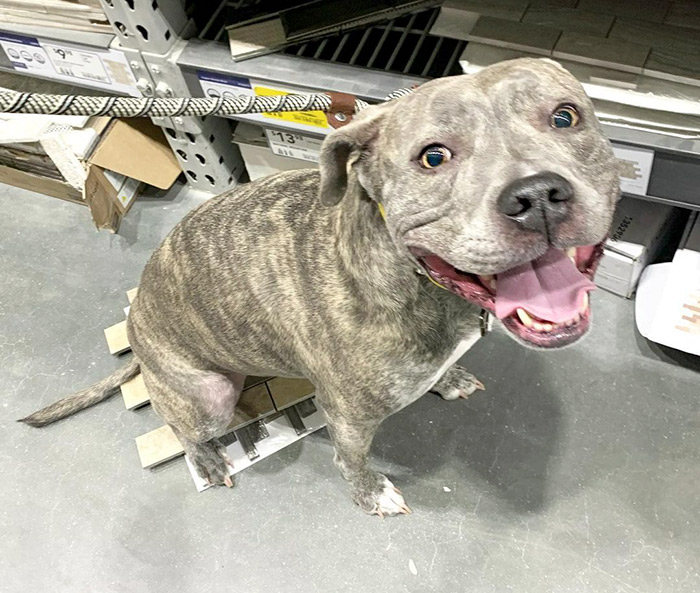
The pitbull is one of the most popular breeds in America. Brought over from England, the dog we know today was bred and popularized in North America. Its expressive face is well-known, but some may be unfamiliar with the brindle pitbull.
1. Brindle is a technical term for a specific coat coloring.
As long as it’s descendant of purebred stock, a brindle pit bull is still a purebred pitbull. It’s not a different breed, just a different color. Brindle coating is similar to that of tiger stripes. It’s not nearly as distinct as the big cats, but fairly noticeable on some coats.
It’s quite similar to tortoiseshell patterns on cats (though we have no idea why there’s a different term for each species).
Often paired with a creamy white underbelly, brindle is usually a fawn to dark brown base coat color with darker stripes, though the reverse is possible. Reverse brindle is a dark base coat with lighter stripes.
Brindles can also have what we call points in their patterns. Points are coloration spots where certain areas of the extremities (tail, feet, ears, etc.) can have a lighter color. This point effect is reminiscent of Siamese cats.
2. The brindle patterned coat forms as a result of a phenotype.
A phenotype is a trait that we can physically observe which was formed by the animals’ genetics. The same thing happens to humans which is why we all have different hair colors and types.
3. The two most common types of brindles you’ll find are Blue Nose Brindle And Red Nose Brindle
Blue Nose Brindle Pit
One of the more popular color brindles is the blue nose brindle pit bull. This breed has a soft blue and gray tone in its coat and a blueish gray-colored nose. Often times the soft blue and gray coat alternates with a light brown or white pattern.
Red Nose Brindle Pit
Similar to the blue nose pit, red nose brindles can be easily spotted by their red or fawn coat and red leather like nose. Their red coats are often mixed with a lighter color such as white or fawn.

4. Brindle patterns in pit bulls aren’t as rare as you would think. They are in fact pretty common.
The rarest colored brindle pit is probably the reverse brindle. In this case, no matter what the colors are, the brindle pattern is reversed, and the coat is the opposite of what it would normally be.
Rarer than brindle, pit bulls can come in pure white, the very recessive merle pattern, and even a tri-color blend reminiscent of a classic Rottweiler.
5. The history of the brindle pit bull is synonymous with any color of the breed.
Pitbulls descended from a mix of the Old English Bulldog and the Old English Terrier, two breeds that don’t exist today. Bulldogs had been used to bait bulls for entertainment and terriers were agile dogs used for fox hunting.
Mixing the two gave us the quick and powerful pit bull who was then imported to America and further bred as a fighting dog. The use many men put these dogs to were often bathed in blood.
The outlaw of bull baiting in 1835 and dog fighting in 1975 happily (from a humane point of view) took jobs away from these dogs.
Today, though they have joined the ranks of beloved family pets in the canine species, pit bulls have yet to shake off their notorious past.
6. Brindle Pit Bull Health issues
Most purebred dogs will suffer from some sort of health problem – the lack of variation in their genes pass on hereditary issues. Pit bulls are no exception.
Here are some of the health problems they are most prone to having;
- Hip dysplasia
- Thyroid disease
- Allergies
- Heart disease
- Cataracts
- Ichthyosis
- Cerebellar Ataxia
- Gastric torsion
A very common issue many breeds suffer from is hip and elbow dysplasia. It causes an uneven gait and joint pain and it is incurable, but can be treated with physical therapy and anti-inflammatory medicines.
There are some genetic tests that can be done to see if your pit is susceptible to some of these conditions, more specifically cerebellar ataxia. But it’s also good to keep in mind that a good reputable breeder will also be able to conduct these tests for you as well.
Having a breeder provide you with the necessary documentation stating that your pit is healthy, vaccinated, and has been examined by the vet is important.
But it should also be noted that once you find the perfect pup for you, you should also take it to get checked out on your own terms just to make sure everything is what it seems.
7. Brindle Pit Bull Temperament
In regard to their temperament, pits can often have an intense and wild look. But be that as it may, don’t let this blockhead you. They are exceptionally adoring and steadfast pets. These canines are splendid and discerning.
Brindle pit bulls are known for being profoundly enthusiastic canines. They have this inconceivable vitality that is a norm for their breed. These canines believe everything to be an undertaking and in doing so they feel glad even with the most everyday assignments.
They will energetically play well with others like it is the most energizing action for the afternoon. And taking them out for a walk or an excursion to the bistro will likewise keep them excited and happy.
(Related: Why You Shouldn’t Take Your Pit Bull To The Dog Park)
8. Are Brindle Pit Bulls dangerous?
Pit bulls are no different than other breeds, in that aggression is a learned behavior. There’s always the chance of coming across one dog who is especially combative.
It’s widely agreed by specialists, though, that breed rarely determines viciousness. It’s a learned behavior that’s instilled by people with bad intentions.
Terrible owners who mistreat their pit bull and don’t treat it like a living animal use fear to force their dog to act aggressively.
Dogs who have only ever known such a life are not used to anything else.
Therefore, there is a chance they can be aggressive, even dangerous, when unprompted.
It’s an explanation of why some of the most serious dog bites reported are by pit bulls – they’re a breed that’s often poorly trained by unsavory types.
When considering the danger of pitbulls, we must wonder if it’s the dogs themselves or the people who make them that way.
(Related: The Truth About Pit Bull Aggression And Attacks)

(photo: rookidontheblock)
9. Despite their fierce reputations, pitbulls are not natural guard dogs.
They’re far too friendly to be effective. Rather than protect against an intruder, these attention-seeking dogs will probably just try to get some belly rubs. It’s ironic, but maybe a testament to the pit bull’s true personality: a lovable family pet.
10. It’s difficult to say if pit bulls are good with other dogs, because the answer isn’t a firm no, but it definitely isn’t yes.
We mentioned that pit bulls are attention seekers. They are needy and anxious and rely on your constant love and support.
If there’s someone else there to take that attention away, it’s a bit like having a jealous sibling. It’s not certain that pitbulls will have problems with other dogs in the family, though.
What can be a deciding factor is whether or not you adopt a puppy or rescue an adult dog. Fully grown pit bulls can be stuck in their ways.
Acclimating them to others may be an impossible task. Adopting a young puppy, however, gives you the opportunity to train it to socialize appropriately with others from an early age. You should always try to train your dog to play well with others, even if it’s just going to the dog park.
11. Trained, well-raised and socialized pit bulls have proven to be great companions for children
It’s important to always supervise these interactions, though. Obviously a dog is not a suitable replacement for a babysitter, even if you’re only in the next room.
Their temperaments are naturally amiable, though, and suitable for families with the right training and socialization.
(Related: Fact Check: Were Pit Bulls Really Nanny Dogs?)
12. If you’re considering a pit bull as your next pet, consider the following: there is a huge stigma around getting a pit bull as a pet.
Like many negative stereotypes, the idea that pit bulls are aggressive and dangerous dogs has been propagated due to a minority of bad owners.
Despite blood sports being illegal, there are some who still breed pit bulls and abuse them.
Even one story of an incident concerning one of these mistreated dogs can effect the overall popularity of a breed.
Sometimes, this stigma has given rise to breed bans, where states or countries put a ban on the entire breed, making it illegal to mate, raise, adopt, or sell dogs of that breed.
A lot of research has proven that these breed bans do not actually curve the number of dog attacks reported each year, even after a breed has been banned for 10 years.
This, paired with many specialists’ evaluations of their friendly dispositions, almost certainly proves how unfounded the stigma against pitbulls are.
However, as untrue as this stigma maybe, if you are considering adding a pit bull to your family, you’ll want to consider a few other things too. Like where you live for example. If you’re renting, many landlords or apartment complexes don’t allow pit bulls on their property.
There are also certain townships that require you to have permits in order to have a pit bull. So you could have to have your pet registered and learn how to abide by the restrictions of that township in order to have a pit as a pet.

(photo: squishy_girl__lexi)
13. A brindle pit bull IS NOT a low maintenance dog.
While their eating and exercise habits are average, their coats easy to maintain, and their health problems no more complex than another breed’s, they are a great addition to the family.
While we don’t deny they would be, we advise thinking it through before falling for their puppy eyes.
Pit bulls are needy. They can suffer nervousness and anxiety if you leave them alone often or for long periods of time.
Pit bulls are a good fit for you if you wiling to put in the time and work to raising a well behaved and social dog.
Training these breeds to be social and attentive early on is imperative for the success of a healthy happy pit.
14. You can buy a puppy for $300 to $700
Most pricing in at the lower end. It depends on if you go breeder or shelter, though.
To adopt a rescue dog, many shelters have recommended donations rather than charging set fees.
The recommended donation does help cover the cost of a check-up, requisite shots, and even spaying or neutering the dog if it isn’t already, so it’s a very good idea to donate that full amount.
It lets you take home a healthy dog and keeps the shelter able to treat others as well!
15. How to find a reputable breeder
It’s understandable to worry about finding reputable pit bull breeders. Some societies exist that specialize in the rescue of pit bulls. They have lists of shelters that provide rescue services who you can contact about adoptions.
If you’re going for a breeder, the best advice we can give is to communicate.
Ask questions about the parents of the litter and ask for health records. Any reputable breeder should keep detailed records for all of their dogs.
They should have proof of the dogs’ vaccines and veterinary check-ups.
A red flag would be a breeder not willing to share this with you.
Another key to communication is actually seeing the puppy beforehand.
If you’ve found a breeder far from where you live, ask to video chat and see the puppy in action before paying a deposit.
Brindle pitbulls are stunning dogs with one-of-a-kind coats. If they take your fancy, there’s no reason not to adopt one. Loyal and gentle, they make great companions.

I see you used my pup, Lexi Mariah, for your article! Great info. Glad her beautiful smile could help educate people. 🙂
Can I buy a puppy?
Yes you can
Do your brindle pitbulls snor.. and how can you tell the difference between the Boxa staffy brindle.. they look so similar..